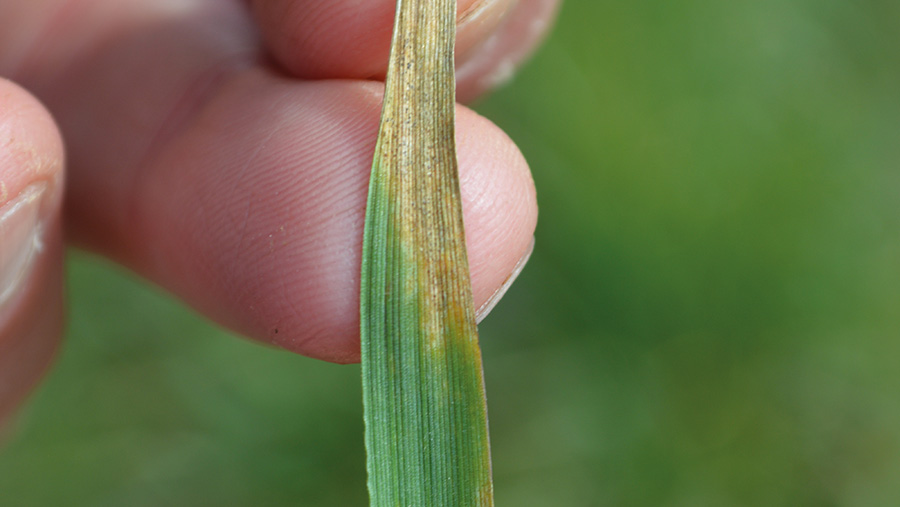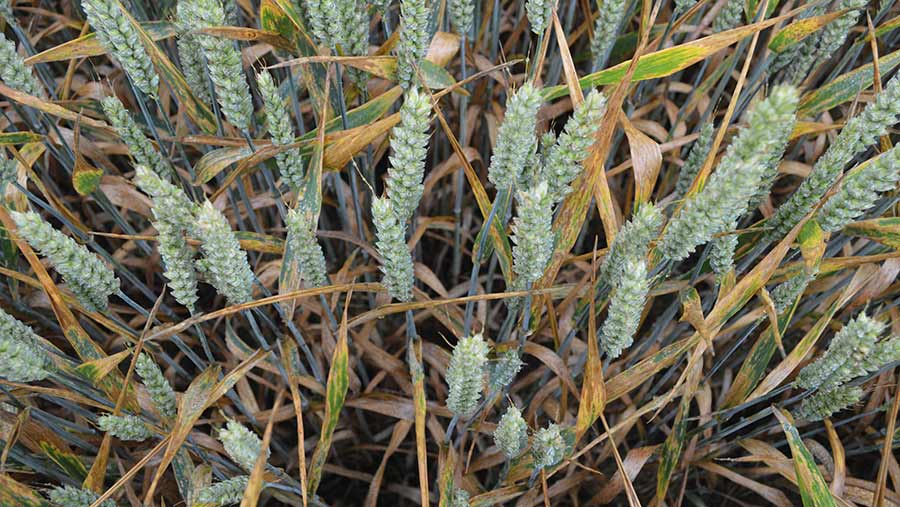Tips on how to keep wheat fungicide costs under control
 Early septoria on wheat © MAG/David Jones
Early septoria on wheat © MAG/David Jones Wheat growers will need to be more vigilant about keeping disease control costs down this season following the banning of cheaper, older fungicides and the likely wider use of more expensive replacements.
They face the first season without the popular multisite chlorothalonil and the azole epoxiconazole which is banned from sale, while they will have a second season’s use of the new azole mefentrifluconazole (as in Revystar), which is very effective but is not cheap.
Although freezing weather in January and February has delayed the development of disease, yellow rust is being picked up in the East, and experts warn that septoria can be found in many crops.
Fiona Burnett, plant pathologist at Scotland’s Rural College, encourages growers to go out and assess crops, question early sprays and try to use older chemistry where appropriate and where disease risks are low.
“Growers need to tailor inputs to the actual risk, and the early driver is yellow rust. If it is not there, then there is scope to drop a T0 spray,” she says.
See also: Yellow rust battle in wheat crops set to get tougher
Driven by yellow rust
Wheat growers often apply a T0 spray at the end of tillering, usually late March/early April, to protect leaf 4, and this season the T0 spray will be largely driven by the threat of yellow rust and not septoria.
With the protectant multisite chlorothalonil now banned, there is little wheat growers can do to control septoria leaf blotch at this early T0 stage, so the main focus will be on yellow rust.
Jonathan Blake, fungicide expert at crop consultant Adas, says the loss of chlorothalonil is a huge loss for septoria control, and while epoxiconazole was probably the strongest active for rust there are good alternatives. Epoxiconazole is banned from sale, but can be used if already on farm.

Jonathan Blake and Fiona Burnett © MAG/David Jones
He suggest growers will need to adjust their programmes according to the season, such as in the dry spring of 2020 when many wheat growers were able to cut back on fungicides early in the year.
“If you are growing a resistant variety and sowing from mid-October onwards there is less disease risk and more chance of cutting back on fungicide use,” he says.
If growers are using wheat varieties with good resistance to septoria and yellow rust, such as Extase, Sundance and Firefly, and they have been drilled late then there is more of an option to cut back.
Early control
For the early T0 spray, Prof Burnett suggests using the relatively cheap azole tebuconazole if yellow rust is present or if there is a major risk of the disease developing, and preferably in a mixture.
She advises that it can be used on its own, or mixed with a strobilurin to give another mode of action and prevent disease resistance building up against fungicides. This should give a relatively cheap mix at T0.
Mr Blake agrees that of those fungicides available, tebuconazole has the edge in performance against yellow rust, but growers should check on the label for its early use. Another azole, metconazole, is also an option at this early stage, he adds.
The key question at the T1 stage will be whether to use an SDHI or not. This T1 spray in late April/early May, when leaf three on the main stem in largely emerged, will again depend of risk factors.
In a low-risk disease situation an azole-multisite may be the best choice, but where there is a higher risk of disease then an SDHI is likely to be added into that mix.
“If you are growing a late-drilled resistant variety then the fungicide yield response will not be as great as with an early-drilled crop using a more disease susceptible variety,” says Prof Burnett.
Strong combination
Mr Blake adds that without the protectant ability of chlorothalonil to control septoria at T0, then there is likely to be wider use of a strong SDHI-azole-multisite combination at T1 this season. These could include SDHI-azole products such as Ascra, Elatus and Revystar along with a multisite, which tend to be the more expensive options.
“With the loss of chlorothalonil, there will likely be a greater need for an SDHI early in the programme,” he says.
With the sales ban on epoxiconazole, an azole-multisite at T1 is likely to be focused on the azole prothioconazole, although Mr Blake says metconazole could be an alternative.
Other experts point out that with no T0 and an azole-multisite at T1, there will be “nothing really substantial” used against septoria until late May at T2, when a SDHI-azole-multisite is likely to be used.
With the banning of chlorothalonil, Prof Burnett advises the use of the alternative multisite fungicide folpet into mixtures to help with resistance management.
Folpet applications in a season are limited to 3 litres/ha, so that could be 1.5 litres/ha at T1 and T2, or as Prof Burnett says for Scottish growers it may be better to use 1 litre/ha at T1, T2 and T3, as T3 ear sprays are common in Scotland due to the long growing season and late harvests.
Fungicide choice
Multisites are protective in action and show little sign of resistance against septoria. On the other hand, they are not curative systemic fungicides like azoles, SDHIs and strobilurins – but these three groups operate on a single site in the disease fungus and can show signs of resistance in the fungus.
The SDHI are very effective at disease control, but they have been shown in the laboratory to be less sensitive, or less effective, at controlling some septoria strains, although this effect has not been seen in the field.

Late septoria in wheat © MAG/David Jones
Therefore from a resistance point of view, SDHIs should be used in mixtures with products with a different mode of action, usually azoles and preferably with a multisite.
Mr Blake adds that folpet’s use makes sense from an economic point of view as it protects in a high-pressure disease season, and slows down resistance building up against other fungicides such as azoles and SDHIs.
“Where septoria is a problem, folpet can make an economic difference,” he says, and suggests the fungicide can be used at T1 and T2.
He points out that an alternative multisite mancozeb could be used at T3, as it show good septoria activity and is also good against microdochium species in the fusarium ear blight complex.
Fungicide actives
Popular azoles
- Tebuconazole (Folicur and other brands)
- Prothioconazole (Proline and other brands)
- Epoxiconazole (Opus and other brands). In farm use-up period
- Metconazole (Sunorg Pro and other brands)
Popular strobilurins
- Pyraclostrobin (Comet)
- Azoxystrobin (Amistar)
Popular SDHI-azole mixes
- SDHIs bixafen and fluopyram + azole prothioconazole (Ascra)
- SDHI fluxapyroxad + azole mefentrifluconazole (Revystar)
- SDHI benzovindiflupyr + azole prothioconaozle (Elatus Era)
Multisite fungicides
- Folpet (Arizona)
- Mancozeb (various brands)
